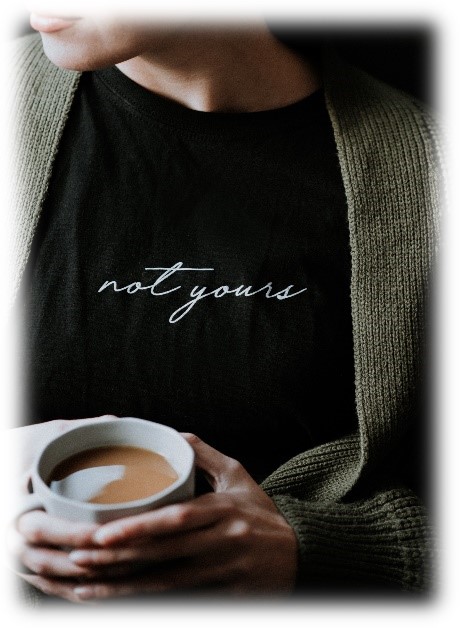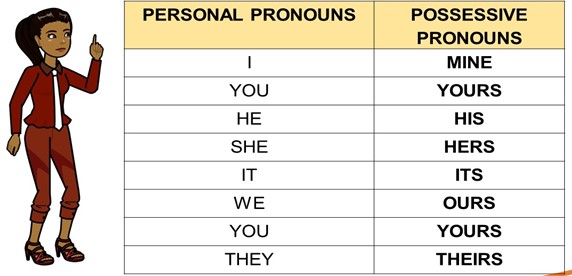I. WHAT ARE POSSESSIVE ADJECTIVES?

They are words that modify the noun to indicate who is the owner or whose possession something is. They also show relationship. You need to use
a possessive adjective + noun
Notice that possessive adjectives are not the same as personal pronouns, but they have their equivalent.


II. WHAT ARE POSSESSIVE PRONOUNS?

Possessive pronouns replace a possessive adjective + noun to avoid repeating information that is already clear. They function as the subject of the verb. Look at the following examples:
“This laptop is mine, not yours”
- Mine replaces my laptop.
- Yours replaces your laptop.
“These sunglasses aren´t mine. Are they yours?”
- Mine replaces my sunglasses.
Yours replaces your sunglasses.
Do you notice the difference? Possessive pronouns always have one form only. It does not matter if they refer to one thing (singular object of possession / “laptop”) or more things (plural object of possession/”sunglasses”). They always remain the same as in the next chart

Let's look at some more examples
1. That is not my iphone. Mine is here.
2. Those are not my goggles. Mine are in my locker.
3. I have my laptop here. Where´s yours?
4. My coffee is cold. Is yours cold too?
5. A: Are those your sunglasses? No, mine are in my handbag.
6. A: Is this your assignment? B: No,it`s hers.
7. A: Is this your home address? B: No,it`s theirs.
8. A: Are your hamburgers tasty? B: Very much! What about yours?
9. A: Is this our mousepad? B: No, not ours. It´s his.
10. Those earpods belong to Jennifer. They are hers.
11. Their orders have arrived but we are still waiting for ours.
12. These suitcases are yours. They have your name on them.
13. My husband and I have a new car. It is finally all ours.
14. Is this Jacob’s ipad? No, it’s not his.
15. The apartment on Oak Street belongs to Mr. and Mrs. Robinson. It is theirs.
III. CONSOLIDATION. NOW TRY THE FOLLOWING QUIZ.
Choose the correct answer complete the following sentences correctly.
IV. LANGUAGE USE PRACTICE
POSSESSIVE ADJECTIVES AND POSSESSIVE PRONOUNS
EXERCISE I. Identify the correct possessive adjective. Choose the correct answer.
EXERCISE II. Identify the possessive pronoun. Choose A, B or C.
IV. READING COMPREHENSION AND VOCABULARY BUILDING
Changing Coffee Culture In Mexico

(I) Unlike in many other coffee consuming countries, coffee is not seen as the morning on-the-go staple, but as an important part of sobremesa (after-lunch) or dinner time, when customers take time for a break after they dine, in order to socialize and relax. Consequently, many coffee shops do not open until late morning. As Mexico City’s coffee culture integrates immigrating coffee influences, the tradition around sobremesa still seems uniquely untouched. Invading second wave coffee giants, like Starbucks, have brought a fast-paced high-volume coffee experience with it, a portfolio of Italian inspired drinks, such as cappuccinos and Americanos. But this hasn’t affected the native coffee culture. One can step into the dusty streets of Mexico City’s Roma neighborhood around 4pm and will find its residents leisurely sipping cortados, lingering and chatting after their afternoon meal. This creates a very different coffee shop culture with places staying open later and a different daily consumer pattern.
(II) While specialty coffee culture may be a new developing concept in the country, drinking coffee more generally has a much longer history, and it is an inherently social affair. In Mexico City, everyone drinks coffee – but just a few drink it the same way. Some are loyal to old institutions such as El Jarocho. Others keep up with the hot new specialty shops on the block. Many drink Starbucks. The common thread that binds them is that coffee in Mexico is a social activity.
(III) There are many producing regions in the country with very different climatic conditions and elevations, which means there is huge diversity in the coffee produced there. Much of country’s coffee growing is in the south, with Veracruz, Chiapas, and Oaxaca being well known producing regions. And collectively, there are thought to be over 500,000 smallholder coffee farming families in the country – highlighting just how important the coffee industry is for both Mexico’s economy and people.
(IV) According to Yañez (2016), Mexico City is transforming itself into one of the most important capitals of specialty coffee as, every day, its citizens learn the language of coffee. The proximity of producers allows coffee roasters and coffee shop owners to have direct connections with farmers in order to obtain the highest quality coffees, and to foster relationships to ensure this quality remains. Mexico is unique because much of its high quality coffee never leaves the country. Actually, a demand for high-quality coffee has been increasing in places like Mexico City, as more and more specialty coffee shops are popping up. Additionally, there are lots of examples of small companies trying to change the way things work in Mexico, by establishing projects to work with local producers to source their coffee directly. For example Café Los Serenos, which sources from four growers in Puebla, and two growers in Oaxaca, according to Drift magazine; or larger projects such as Café con Jiribilla, which works with producers from Oaxaca, Guerrero and Veracruz.
(V) As for the future for coffee culture in Mexico, it must be pointed out that Mexico has a rich coffee history, intertwined with politics, economic, social and environmental change in the country. It is true that while there are challenges for the coffee industry in Mexico, it is clearly an area of the world where the coffee culture, and the coffee growing industry, is experiencing change; one to watch closely in future years.
V. PRACTICE I
For each question or statement, mark the correct anwer.
BIBLIOGRAPHY
Azar, B. S., Azar, D.A., & Koch R.S. (2009). Understanding and Using English Grammar. Longman.
Barker C. and Mitchell, L. (2004). Mega 1 (First Ed.). Macmillan Publishers.
Hewings, M. (2013) Advanced Grammar in Use with Answers: A Self-Study Reference and Practice Book for Advanced Learners of English. Cambridge University Press.
Murphy, R. (2012). English Grammar in Use. Ernst Klett Sprachen.
Murray, L. (2014) English Grammar. Cambridge University Press.
Berry, R. (2018). English grammar. Routledge.
Leech, G., & Svartvik, J. (2013). A communicative grammar of English. Routledge.
WEB RESOURCES
Image 1_ Free stock photos_https://www.pexels.com/photo/text-cutouts-on-a-dotted-background-5941445/Photo by Eva Elijas from Pexels.
Image 2_ Free stock photos_ https://www.pexels.com/photo/lounge-chair-on-wooden-tropical-terrace-5028910/Photo by Evgenia Basyrova from Pexels.
Image 3_ Free stock photos_https://www.pexels.com/photo/crop-woman-with-cup-of-aromatic-coffee-6353855/Photo by Anete Lusina from Pexels.
REFERENCES
Chart 1&2. Own source
- Kitain, A. (2016) Mexico City. Caffeine. April May, p.26-29.
- ICO (2017) Total production. ICO. Available at: http://www.ico.org/prices/po-production.pdf
- Perfect Daily Grind (2017) Mexico is World of Coffee 2017 Portrait Country. Perfect Daily Grind, 8th Available at: https://www.perfectdailygrind.com/2017/06/mexico-world-coffee-2017-portrait-country/
- Plascencia, D (2016) A Specialty Coffee Shop of Guadalajara, Mexico. Perfect Daily Grind, 16th Available at: https://www.perfectdailygrind.com/2016/11/specialty-coffee-shop-tour-guadalajara-mexico/
- Starbucks (2016) Starbucks Mexico’s Coffee Tree Initiative Grows. Starbucks Newsroom 31 May. Available at: https://news.starbucks.com/news/starbucks-mexicos-coffee-tree-initiative-grows
- Yanez, E (2016) Coffee Paradise: 5 Must-visit Specialty Cafes in Mexico City, Perfect Daily Grind, 7th Available at: https://www.perfectdailygrind.com/2016/04/coffee-paradise-5-must-visit-specialty-cafes-mexico-city/
- Retrieved and adapted from: http://sprudge.com/a-coffee-lovers-guide-to-mexico-city-118233.html in https://cafespaces.wordpress.com/2018/01/03/changing-coffee-culture-in-mexico/comment-page-1/
CREDITS
- (2021) Practice exercise written by Connie Reyes-Cruz_Language Department at ENES-LEON UNAM
- Audio version performed by Sally and Matthew_Voicemaker_Text to Speech Converter_Connie Reyes 2022 Subscription
- Story posted by Jennifer Ferreira. Published on January 3, 2018. Text retrieved and adapted from _http://sprudge.com/a-coffee-lovers-guide-to-mexico-city-118233.html in https://cafespaces.wordpress.com/2018/01/03/changing-coffee-culture-in-mexico/comment-page-1/
- Practice exercise written by Connie Reyes_ Foreign Language Department at ENES-LEON UNAM
- Audio version performed by Sally_Voicemaker_Text to Speech Converter_Connie Reyes 2022 Subscription
- Free stock photos_https://www.pexels.com/photo/food-man-people-coffee-4927142/ Photo by Anna Tarazevich from Pexels